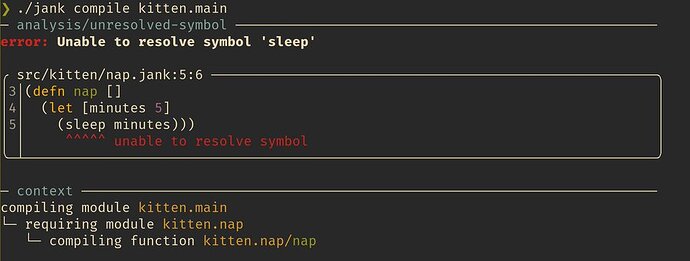what follows is an error message I get when my precondition assertion fails . I wonder, do y’all have anything in place that gives nicer error messages? . is there something I’m missing here which those-in-the-know utilize? . in this case, eg, I would love it if it left out the stack trace (— is that what it’s called, a ‘stack trace’?)
and please nobody make a case for why the error messages as they are are great . they are not great
------ REPL Error while processing ---------------------------------------------
(app.dom/evaluate "borf")
Encountered error when macroexpanding app.dom/evaluate.
AssertionError: Assert failed: (even? (count forms))
app.dom/evaluate (dom.cljc:10)
app.dom/evaluate (dom.cljc:10)
clojure.core/apply (core.clj:671)
clojure.core/apply (core.clj:662)
cljs.analyzer/macroexpand-1*/fn--3704 (analyzer.cljc:4025)
cljs.analyzer/macroexpand-1* (analyzer.cljc:4023)
cljs.analyzer/macroexpand-1* (analyzer.cljc:4010)
cljs.analyzer/macroexpand-1 (analyzer.cljc:4074)
cljs.analyzer/macroexpand-1 (analyzer.cljc:4070)
cljs.analyzer/analyze-seq (analyzer.cljc:4107)
cljs.analyzer/analyze-seq (analyzer.cljc:4087)
cljs.analyzer/analyze-form (analyzer.cljc:4296)
cljs.analyzer/analyze-form (analyzer.cljc:4293)
cljs.analyzer/analyze* (analyzer.cljc:4349)
cljs.analyzer/analyze* (analyzer.cljc:4341)
shadow.build.compiler/analyze/fn--13434 (compiler.clj:266)
shadow.build.compiler/analyze (compiler.clj:254)
shadow.build.compiler/analyze (compiler.clj:211)
shadow.cljs.repl/repl-compile/fn--15150/fn--15151 (repl.clj:515)
shadow.cljs.repl/repl-compile/fn--15150 (repl.clj:488)
shadow.cljs.repl/repl-compile (repl.clj:486)
shadow.cljs.repl/repl-compile (repl.clj:483)
shadow.cljs.repl/process-read-result (repl.clj:574)
shadow.cljs.repl/process-read-result (repl.clj:550)
shadow.cljs.repl/process-input (repl.clj:713)
shadow.cljs.repl/process-input (repl.clj:691)
shadow.cljs.devtools.server.worker.impl/fn--15676 (impl.clj:698)
shadow.cljs.devtools.server.worker.impl/fn--15676 (impl.clj:688)
clojure.lang.MultiFn.invoke (MultiFn.java:234)
shadow.cljs.devtools.server.util/server-thread/fn--15350/fn--15351/fn--15359 (util.clj:283)
shadow.cljs.devtools.server.util/server-thread/fn--15350/fn--15351 (util.clj:282)
shadow.cljs.devtools.server.util/server-thread/fn--15350 (util.clj:255)
java.lang.Thread.run (Thread.java:840)

